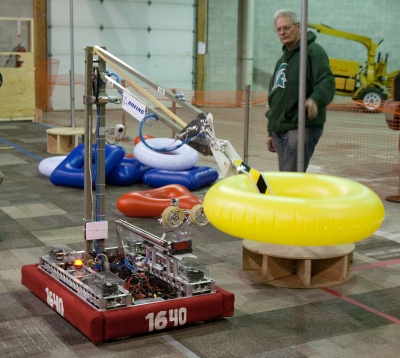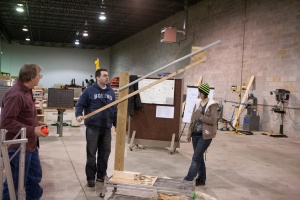Difference between revisions of "DEWBOT VII Arm"
MaiKangWei (talk | contribs) |
MaiKangWei (talk | contribs) (→Concepts - Arm) |
||
| Line 29: | Line 29: | ||
==Concepts - Arm== | ==Concepts - Arm== | ||
| − | [[image:DB7_new_prototype_110117_csm.jpg| | + | [[image:DB7_new_prototype_110117_csm.jpg|300px|right|thumb|Gary Deaver, Rich Kulik & Molly with 2<sup>nd</sup> 4-bar prototype]]Three main concepts were examined for the Arm itself |
:# A lift | :# A lift | ||
:# An arm with articulated shoulder & elbow (and a means to adjust logo piece orientation) | :# An arm with articulated shoulder & elbow (and a means to adjust logo piece orientation) | ||
Revision as of 03:35, 13 March 2011
DEWBOT VII's arm was developed to meet the following key strategic objectives:- Elevate possessed Logo Pieces to score at all levels - esp. top - NEED
- Quickly and reliably score Logo Pieces on Scoring Grid - NEED
- Disengage cleanly from Logo Piece & Tower after scoring - NEED
- Assure Logo Piece orientation to facilitate scoring - NEED
- Align Logo Piece with target - z (height) - NEED
- Securely possess inflated Logo Pieces & Ubertubes - NEED
- Pick inflated Logo Pieces off field - NEED
- Load inflated Logo Pieces at Feeder Station - NEED
- Close claw when Logo Piece is at correct penetration - WANT
- Ubertube manually loadable with robot powered-down - NEED
And a few game constraints
- Arm must be manually movable with robot powered down - NEED
- Arm must be within starting envelope at beginning of match - NEED
- In play, arm may not break the 84" cylinder limits - NEED
Not to mention some engineering considerations
- Robot center of mass should remain low & centered for stability
- Arm must be robust & reliable
- Easy to use
Material Constraints
The team's decision to build a Pivot Drive-Train limited the motors available for the arm & Minibot deployment. These were:
- (1) FischerPrice Motor; and
- (4) Denso window motors.
Pneumatics were also available for the arm & Minibot Deployment.
Concepts - Arm
Three main concepts were examined for the Arm itself- A lift
- An arm with articulated shoulder & elbow (and a means to adjust logo piece orientation)
- A 4-bar linkage arm with a 2-position articulated wrist (pick-up v. score) and a claw which tucked into the envelope at game start, then deployed at the beginning of autonomous.
The lift was dropped due to considerations that it was too complex, likely to be heavy, and unreliable.
More detailed analysis was performed on the two arm concepts (below) and a prototype of the 4-bar design constructed and tested.
Analysis of arm motion for a robot with a 2-joint arm playing Logomotion. 12 Jan 2011, Clem
Arm analysis 2 for a robot with a 2-joint arm playing Logomotion, includes all scoring pegs. 15 Jan 2011, Siri
4-Bar arm analysis for single-pivot arm playing Logomotion. 17 Jan 2011, Siri
4-Bar CAD report including all configurations with dimensions and actuation (pneumatic cylinders). 28 Jan, Siri.

